........problems and solutions |
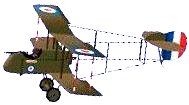
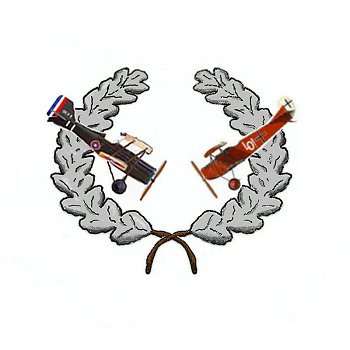
Designing realistic but playable flight dynamics for a simulation involves a measure of compromises. Being purely realistic is impossible, and too much "realism" can actually detract from such realism. This page seeks to provide some background for those curious why simulator planes fly the way they do. Aircraft slice through air, much like submarines move through water. For that matter, air has much the same dynamic as water, only the latter is more dense. Because of the 3-dimensional aspect of flight, aircraft can move on 3 axes. These are longitudinal (length of the machine), lateral (side-to-side of the machine), and normal (top-to-bottom, or vertical). |
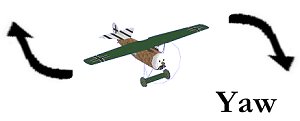
Item 1: YAW... Yaw is the rotational motion of an aircraft along the normal, or vertical, axis of the plane. Yaw is controlled by several factors, among them the shape of the fuselage and the presence or absence of vertical tail surfaces. The weight of the fuselage will determine the intensity of yaw, as will distribution of such things as the engine and fuel tanks. The heavier the plane, often times the more inertia (the more force needed to move the plane, and the longer the plane will slide after rudder is applied). When a pilot kicks his rudder, the plane seems to shift from one side to the other, but in reality is swinging along the vertical axis. When a "virtual designer" creates a flight sim plane, he uses rudder control factors, yaw stability and yaw inertia to create the correct effect. Too much yaw, or incorrect stability, and the plane may "shimmy" side to side. If you see a plane doing this, that is often the problem. This shimmy can be intentional.... built into the design to create a desired effect, such as when the plane dives too fast. |
Item 2: Roll... Roll is the rotational motion of an aircraft along the longitudinal axis of the plane. Roll is controlled by such factors as wing shape and structure (such as amount of dihedral) and aileron placement and effectiveness. Dihedral is one critical item, and is the outward angle of the wings in relation to the fuselage. Increased dihedral allows air to flow outward as it goes beneath the wings, in essence, "squeezing" the fuselage into a stable flying motion. Some planes, especially WW I machines, had virtually no dihedral. Modern aircraft almost always have wing dihedral. As to the roll itself, this is determined by the effectiveness of the ailerons coupled with the actual weight of the wing. However, often forgotten in this mix is the weight of the fuselage. Even though it is close to the center of the roll, fuselage weight will effect the roll's quickness. Weight on the outside of the wing also plays a critical role. The more weight on the outer edges, usually the slower the roll and the more inertia, and this can be increased by the addition of wing-mounted weapons. However, other factors can improve these characteristics. Virtual flight designers can stablize roll and reduce or increase the inertia. If you're flying a plane and it seems to roll slightly back and forth at will it is usually because the roll was not stabilized or dampened. Designers can also use inertia to simulate the actual "feel" of flight when you roll the plane over. |
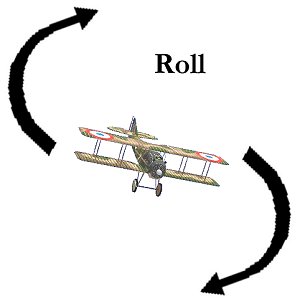
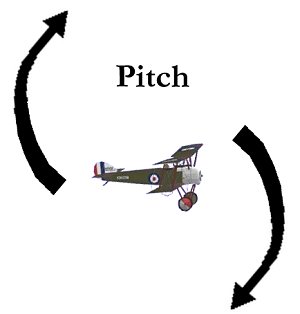
Item 3: Pitch... Pitch is the motion of the nose moving up and down along the lateral axis, and it is here where many virtual flight designers run into trouble. Pitch is caused primarily by the distribution of weight in the fuselage...... engine, fuel tanks, weapons, cockpit and pilot. The positioning of these has a tremendous impact on the pitch of the plane. But often forgotten is the actual location of the centerline of the wing, and the wing's chord (the straight line between the leading and trailing edges of the wing). Sometimes designers wish to incorporate excess pitch into their work to create a realistic effect. After all, pointing and aiming a flying machine at another moving object is not easy work! But this is where they often run into trouble. In real life, the human eye and brain has a built-in stabilization system. When out and about, we see incidents involving pitch all the time, but our eyes have the means to keep focused on the item we are looking at. The very motion of walking involves pitch! Problems with pitch only become severe when it is excessive, or our vision is narrowed, such as when looking through binoculars. One of the techniques some army tank commanders try to master is using binoculars while the tank is actually moving. It is no easy task, because the oscillations of the tank causes the image to "bounce" out of view. This is a similar problem with virtual design. The virtual pilot's vision is narrowed by the monitor, much like looking in binoculars. If the pitch, however realistic, is too excessive it actually detracts from the realism, making the simulated plane next to impossible to use, not to mention unenjoyable to fly. |
Flight Dynamics for Combat Flight Simulator.......... |